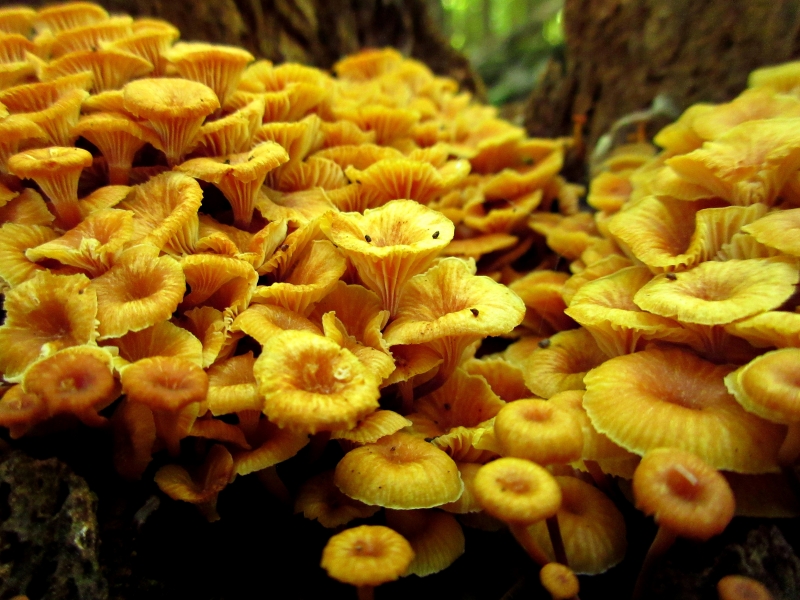
Fungi Forest. Encounter: Rhiannon Clements
Fungal Homes: Much Room, No Mushrooms
For some reason, mushrooms have spawned more than their fair share of puns. As a kid I learned that they’re all fun-guys, and that the only rooms you can’t enter in a house are mushrooms. The last one might not work these days, as entire buildings are now being made of fungus.
Given that mold inside our homes can make us ill, you wouldn’t think that being surrounded by the stuff would be a great idea. But just like so many other things in life, “it depends.” As a building material, fungus is cheap, ubiquitous, and a renewable resource. But that’s not the best part. By dry weight, walls made of fungus are stronger than concrete and have better insulation value than polyurethane foam. They are weather-proof, practically non-combustible, and oddly enough, resist getting moldy.
Just to define a few terms, mushrooms are the visible spore-bearing structures of a given species of fungus, the main body of which is hidden from sight in nearly all cases. They range from familiar culinary types like Shiitake to woody conks found on tree stumps to oddities like the gossamer lion’s-mane prized by ’shroom hunters in regional forests. Please don’t build a house from these – you may be well-fed, but you’ll also be cold and damp.
The fungal body, a mass of tangled filaments collectively called mycelium, is what is actually used for purposes of construction. In spite of its name, mycelium is good for walls, but not overhead (in other words, not for the “celium”). Organic matter, often sawdust, grain chaff or other readily available by-product, is packed into a form and inoculated with a desired fungus. In this way, fungal building blocks of many sizes and shapes can be grown in-place.
Once inoculated, bricks of sawdust become infused with thread-like filaments that firmly bind the organic matter together. The fungus is only allowed to grow to a certain point before being intentionally killed, however. This can take days to weeks depending on fungal species, substrate, block size and temperature. A builder chooses the endpoint that provides the best combination of strength and insulation properties. If allowed to continue, the mycelium would become nearly solid and lose its heat-holding value.
One of the most impressive aspects of building this way is that just prior to being “mature,” mycelium blocks can be stacked on top of one another and allowed to fuse together before the growth process is halted. The resulting wall effectively becomes one piece. Entire mycelium panels akin to pre-fabricated walls are also being grown. These can either be bonded to a non-fungus exterior skin like wood or fiberglass for greater durability in the weather, or used bare.
In 2014, a whimsically shaped and imposing mycelium tower was built on the grounds of the Museum of Modern Art in New York City. I encourage you to do a web-image search (unfortunately the Museum no longer has pictures available on its website) – you’ll be suitably wowed. Other websites showcasing fungal construction include https://www.certifiedenergy.com.au/emerging-materials/emerging-materials-mycelium-brick and https://criticalconcrete.com/building-with-mushrooms/
As you may have guessed, there are limitations, or your friends and neighbors would likely be building this way already. Although stronger than cement by weight, mycelium does not have the same compression strength, so at the moment, high-rise buildings are out of the question. And because it is such a novel material, it will probably be some time before being widely integrated into building codes.
Heat-cured mycelium blocks are quite durable and water-resistant, but are not infinitely so. Right now it’s estimated that in temperate regions with plenty of annual precipitation, fungal-block walls exposed to the weather will probably last twenty years before starting to degrade. To be fair, though, the same can be said of an unpainted wood wall, so it stands to reason that protective coatings will extend this considerably.
Today you can buy mycelium faux-leather wallets and accessories, and in the near future you are sure to be getting mycelium-based packing materials rather than bubble wrap when you order from major companies. I hope it’s not too long before fungal houses begin popping up in the landscape – it’s the morel way to build.
Paul Hetzler, a former Cornell Extension Educator, is trying to be a fun guy. He might buy a spores car.

